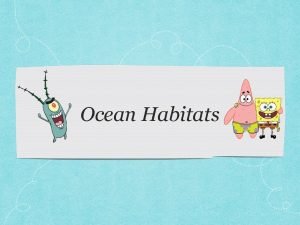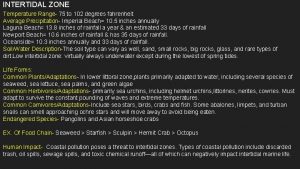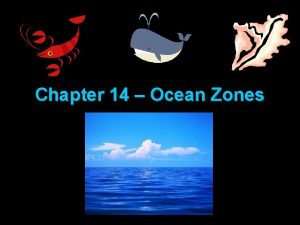INTERTIDAL ZONE Temperature Range 75 to 102 degrees


- Slides: 2

INTERTIDAL ZONE Temperature Range- 75 to 102 degrees fahrenheit Average Precipitation- Imperial Beach= 10. 5 inches annually Laguna Beach= 13. 8 inches of rainfall a year & an estimated 33 days of rainfall Newport Beach= 10. 6 inches of rainfall & has 35 days of rainfall. Oceanside= 10. 3 inches annually and 33 days of rainfall. Soil/Water Description-The soil type can vary as well, sand, small rocks, big rocks, glass, and rare types of dirt. Low intertidal zone: virtually always underwater except during the lowest of spring tides. LIfe Forms: Common Plants/Adaptations- In lower littoral zone, plants primarily adapted to water, including several species of seaweed, sea lettuce, sea palms, and green algae Common Herbivores/Adaptations- primarily sea urchins, including helmet urchins, littorines, nerites, cowries. Must adapt to survive the constant pounding of waves and extreme temperatures. Common Carnivores/Adaptations-Include sea stars, birds, crabs and fish. Some abalones, limpets, and turban snails can smell approaching ochre stars and will move away to avoid being eaten. Endangered Species- Pangolins and Asian horseshoe crabs EX. Of Food Chain- Seaweed > Starfish > Sculpin > Hermit Crab > Octopus Human Impact- Coastal pollution poses a threat to intertidal zones. Types of coastal pollution include discarded trash, oil spills, sewage spills, and toxic chemical runoff—all of which can negatively impact intertidal marine life.

Savanna Weather- 68°- 86° F Average Precipitation - 50” Common Plants- Lemongrass, Chloris Gayana, Scutch Grass, Acacia, Baobab Tree. Due to the dry seasons in the savanna plants must store large amount of water and energy in their roots or have roots long enough to reach deep into low water tables Common Herbivores- zebras, wildebeests, elephants, giraffes, ostriches, gazelles, and buffalo. Adaptations against rival predators are necessary , these adaptations come in different ways whether it might be strength, speed, or long necks to spot dangerous predators. Soil Description- The savanna soil is fertile and composed of thin layers: O Horizon is made up of dark hummus, A and B horizons are a combination of a hard cemented layer and redesposited silica, and finally the C horizon is bedrock. Human Impact- humans have been known to overgraze land thus causing grasses to deplenish and allowing the sahara desert to expand into this biome 30 miles per year. Another impacts by humans are the destruction of animal’s habitats and hunting down species until the point of endangerment. Common Carnivores- lions, hyenas, cheetahs, leopards, black mambas, and wild dogs. These predators have adapted relatively to their qualities, whether its speed or hunting in pack. Endangered species- The african bush elephant is an endangered species inhabiting the savanna biome, these elephants have suffered a population collapse due to the overhunting and loss of habitat. Food Chain- leaves > Antelope > African wild dog > Lion



